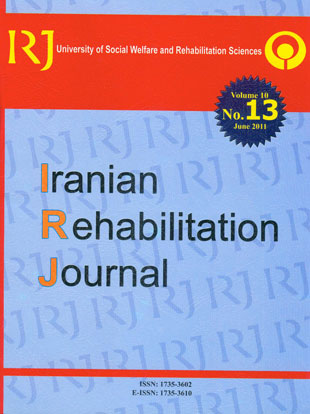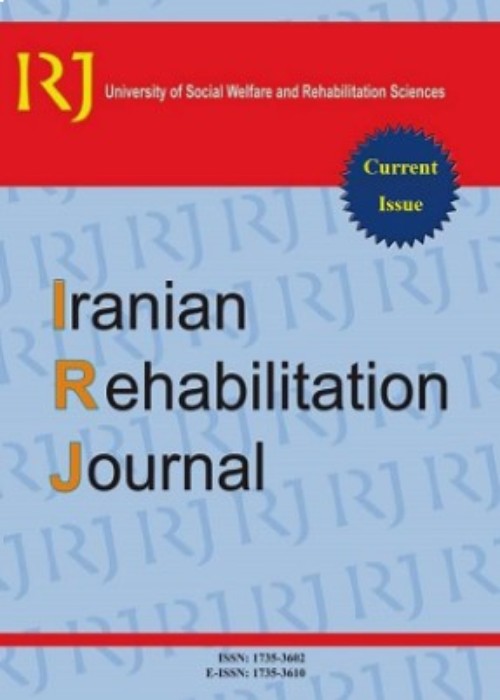فهرست مطالب

Iranian Rehabilitation Journal
Volume:9 Issue: 13, Apr 2011
- تاریخ انتشار: 1390/10/11
- تعداد عناوین: 8
-
-
Page 3ObjectivesThe aim of this study was to translate the Craig Hospital Inventory of Environmental Factors (CHIEF) into Persian language and to evaluate the validity and reliability of Persian version of CHIEF to use for children with cerebral palsy.MethodsThe CHIEF was translated from English into Persian based on the International Quality of Life Assessment (IQOLA) approach. The Persian version of the CHIEF has been completed with a convenience sample of 75 caregivers of children with cerebral palsy. Two weeks after the first completion, 20 caregivers completed CHIEF again in the retest session. The CHIEF questionnaire consists of 25 items divided in to 5 subscales. Its item discriminant validity was calculated using spearman's rank correlation, test-retest reliability using Intraclass Correlation Coefficient (ICC) and Standard Error of Measure (SEM), and Internal consistency using Cronbach's coefficient α.ResultsThe results demonstrated that more than 96% of items correlated strongly with its own subscale rather than other subscales (r > 0.40). The values of the ICC were > 0.70 and the values of the SEM were ≤ 1 for the score of subscales and total score. Cronbach's coefficient α for the overall scale was 0.86.ConclusionsThe Persian version of the CHIEF has acceptable levels of face validity, construct validity, item discriminant validity, test-retest reliability, and internal consistency to use for children with cerebral palsy.
-
Page 11ObjectivesDeterioration in postural control mechanisms is termed postural instability and results increased postural sway and many laboratory techniques and instruments are characterized by a wide range of neurological signs and symptoms to the medical management. Thus the current study designed to assess the reliability of commonly used clinical measures of balance and determined normal values. Also, the second purpose was to evaluate the scrutiny of age, length; weight and body mass index (BMI) effects on performing clinical balance tests.MethodOne hundred and thirty three participants (18-59 years), that have at least three time sports activity in one week, performed three timed tests including Time-up and Go (TUG), Tandem Gait (TG), and Walking on Balance Beam (WOBB) on firm surface.ResultsReliability data were produced for each tests of motor performance. We found that the first performance of three trials was slower, and the relationship between some factors and these battery tests were examined. Means (± SD) for each measure were averaged across three trials. Time to complete TG was 13.6 ± 1.1s. TUG value was 6.9 ± 1.03 and WOBB was 6.9 ± 1.03s.Conclusionsour results revealed that three clinical balance test batteries - TUG, TG and WOBB tests are the stability measures to assess the sports related concussion. Also, the results of current study showed that the time to perform these tests was slower than the other studies.
-
Page 16ObjectiveLow Birth Weight neonates need complementary interventions (e.g. tactile kinesthetic stimulation) to promote their development. This study was conducted to determine the effect of Tactile- Kinesthetic Stimulation (TKS) on motor development of Low Birth Weight neonates.MethodIn this clinical trial study, sample was made out of 40 inborn LBW neonates who were divided into two groups randomly. TKS was provided for three 15-minute periods per day for 10 consecutive days to the test group, with the massages consisting of moderate of pressure strokes in prone position and kinesthetic exercises consisting of flexion and extension of limbs in supine position. All measurements were taken before and after completion of the study with the same equipment and by the same person.ResultsResults indicated that motor behavior in the intervention group was significantly higher than the control group after the 10 days TKS (P-Value≤0.0001).DiscussionTKS could be an effective intervention in development of motor behavior of LBW neonates. Because very little is known about neonate's behavior, it seems to need more studies in other aspects of behavior in LBW neonates.
-
Page 19ObjectivesThe purpose of the present study was comparing visuo-spatial attention between children with Attention Deficit Hyperactivity Disorder-Inattentive (ADHD-I) type and normal children. Method and Material: In this cross-sectional study fifteen (7-10 years of age) children were classified with ADHD-I type and 15 normal children were matched for age, sex, and IQ. They were selected trough simple random sampling. Measurement tools were Wechsler Intelligence Scale for children 4th edition (WISC-IV), the Edinburgh Handedness Inventory and the Star Cancellation Test.ResultsThe results suggest that there is no significant difference between ADHD-I and normal children from the visuo-spatial standpoint (p>0/05). But three ADHD-I children exhibited signs of unilateral neglect.DiscussionAlthough, in this study the visuo-spatial attention was not different between ADHD-I group and normal group, considering this form of attention as an item in assessment and therapeutic interventions should not be neglected.
-
Page 22Background And ObjectiveDown syndrome is the most common chrosomal disorder in which the fine and gross motor skills due to lack of proper sensory experience are disturbed. The role of dexterity in activity of daily living, interaction with environment and independency is quiet crucial in Down syndrome. Therefore, the aim of this study was to investigate the effects of simultaneous application of superficial and proprioceptive stimuli on the dexterity of 6-7 year-old educable children with Down syndrome. Methods and Materials: Thirty–three educable children with Down syndrome were assigned in three groups (i.e. superficial, proprioceptive and simultaneous application respectively) and voluntarily participated in the study. In the first group, children received only exteroceptive stimulation for 30 minutes, three times a week. Children in the second group received only proprioceptive stimulation in the same way. In the third group, children received both stimulations simultaneously. Dexterity was evaluated through Purdue Pegbourd Test after 5th, 10th, 15th, 20th, 25th, and 30th sessions.ResultsDexterity changes were significantly differed in all three groups (p<0.05) using repeated measurement test. In order to assess the improvement process of Dexterity, every group was evaluated separately with Purdue Pegboard Test. The third group showed significant improving comparing to other groups (p<0.05). There was no significant improvement in dexterity in the first and second groups (p>0.05).DiscussionThe findings of current study suggest that simultaneous application of superficial and proprioceptive senses could be used for improvement the dexterity in children with Down syndrome.
-
Page 26ObjectiveThere are some controversies about the value of modified Ashworth Scale (MAS) for assessing spasticity. The goal of this study was to investigate if there is any correlation between scores obtained from MAS for wrist spasticity and electrophysiological recordings as the objective measure of spasticity.MethodsIn this cross-sectional study, 34 stroke patients were employed. Wrist spasticity was clinically measured by means of MAS. Also, an electromyogram (EMG) machine was used to elicit Hmax and Mmax from the flexor carpi radialis muscle. Spearman’s correlation coefficient test was used to investigate potential correlation between clinically and electrophysiologically measures of spasticity.ResultsThe observed relation between MAS and EMG recordings was not statistically significant (rho=0.183 P>0.05).DiscussionOur findings suggest that MAS may be a useful tool for grading hypertonia, but it is not a valid measure of spasticity in selected patients.
-
Page 31ObjectivesMovement is a continuous aspect of life and an important factor to achieve the goals and meet the needs. Regarding the importance of infantś motor assessment and the large number of children with motor disorders, a valid and reliable test is required to help evaluation of motor development and provide appropriate interventions by therapists and educators. This study was implemented in order to investigate the validity and reliability of PDMS in 0–24 months infants in Tehran.MethodThis cross-sectional study was conducted through descriptive-analytic procedures, 110 infants were selected using randomized cluster sampling regarding the inclusion criteria.ResultsThere was no significant difference between the male and female on mean motor age and motor development quotient (P>0/05). However, significant correlation between total mean motor age and motor developmental quotient was observed (P<0/05).ConclusionResults of the study indicated that PDMS is a valid and reliable tool to enhance quality of assessment, diagnose and proper intervention for movement disorders in early childhood.
-
Page 34ObjectivesThe main purpose of the present study is to consider the rate of impression in group mental rehabilitation based on the regulation of self recognition sources on augmentation of self-respect among 14- to 18-year old female prisoners.Method30 female social seekers were randomly selected from the whole population, 15 of which were gathered in control group and the rest 15 within evidence group. First, GHQ papers (General Health Questionnaire) were distributed among the girls in order to evaluate their mental status. Pre- and Post- Cooper Smith self-respect tests were formulated both before and after interventions on experiment group. Interventions were accomplished during 9 sessions within three months by group consulting based on the configuration of self-recognition (collected by Younesi 2007). Considering the point that remedy plans are not utilized for the evidence group and they are evaluated by gathered marks achieved by the two tests to compare average discriminations.ResultsAfter applying remedy interventions, social seekers from experimental group manifested meaningful augmentation during the test of self-esteem invented by Cooper Smith compared with social help seekers from control group.DiscussionsThe findings indicated that group mental rehabilitation would increase self-esteem in its four dimensions among the subjects. The findings showed that mental rehabilitation based on self knowledge resources is useful for improvement of juvenile detainee's self-esteem.


